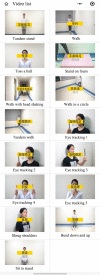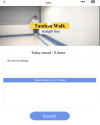WeChat-based vestibular rehabilitation for patients with chronic vestibular syndrome: protocol for a randomised controlled trial
- PMID: 33653749
- PMCID: PMC7929820
- DOI: 10.1136/bmjopen-2020-042637
WeChat-based vestibular rehabilitation for patients with chronic vestibular syndrome: protocol for a randomised controlled trial
Abstract
Introduction: Dizziness is one of the most common symptoms seen in chronic vestibular syndrome, which has been linked to an increased risk of falls, substantial disability and negative psychological consequences. Recent evidence demonstrated that vestibular rehabilitation therapy (VRT) is effective for treating chronic vestibular symptoms. However, the delivery of VRT remains challenging because of lack of facility, insufficient qualified physiotherapist resources, as well as being in the actual situation of the pandemic. WeChat, the most widely used mobile app in China, offers a more viable way of delivering VRT than traditional office-based approaches do. This study aimed to evaluate the effectiveness of the WeChat-VRT programme for patients with chronic vestibular syndrome.
Methods and analysis: This is a parallel-group, assessor-blinded randomised controlled trial. Fifty patients who experienced chronic vestibular symptoms longer than 3 months will be randomised into either the WeChat-VRT group or the usual care (UC) group. Participants in the WeChat-VRT group will receive 8-week VRT mainly through the WeChat app. Participants in the UC group will receive once-weekly VRT in the clinic for 8 weeks and remaining time home-based exercise. Outcome assessments will take place at baseline and at the 8th, 12th and 24th weeks after randomisation. The primary outcome will be the change from baseline to the eighth week on the patients' functional improvements quantified by the Functional Gait Assessment (FGA). The secondary outcomes will include dynamic balance function, emotional well-being, and vestibular activity and participation level. Intention-to-treat analysis will be performed using generalised estimation equation modelling.
Ethics and dissemination: The trial has been reviewed and approved by the Institutional Review Board of Eye and Ear Nose Throat Hospital of Fudan University (reference number 2017047/1). The study findings will be disseminated via peer-reviewed journals and conferences.
Trial registration number: ChiCTR2000029457; Pre-results.
Keywords: adult otolaryngology; quality in health care; rehabilitation medicine.
© Author(s) (or their employer(s)) 2021. Re-use permitted under CC BY-NC. No commercial re-use. See rights and permissions. Published by BMJ.
Conflict of interest statement
Competing interests: None declared.
Figures
References
Publication types
MeSH terms
LinkOut - more resources
Full Text Sources
Other Literature Sources
Miscellaneous




